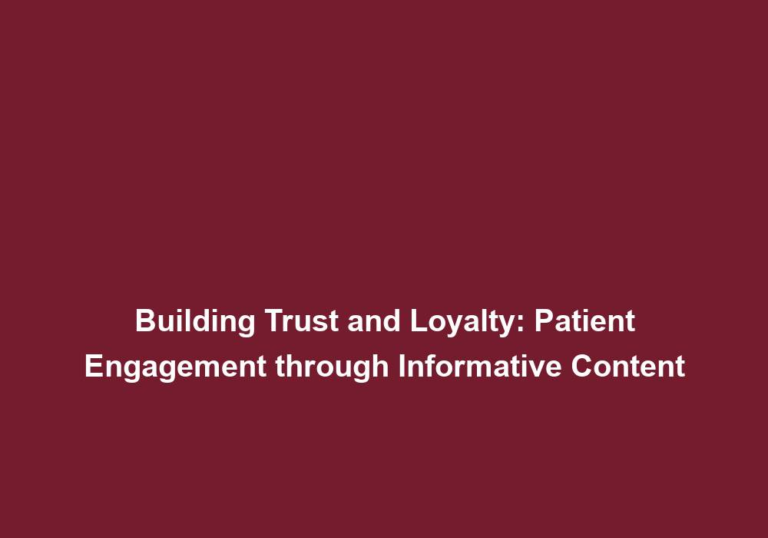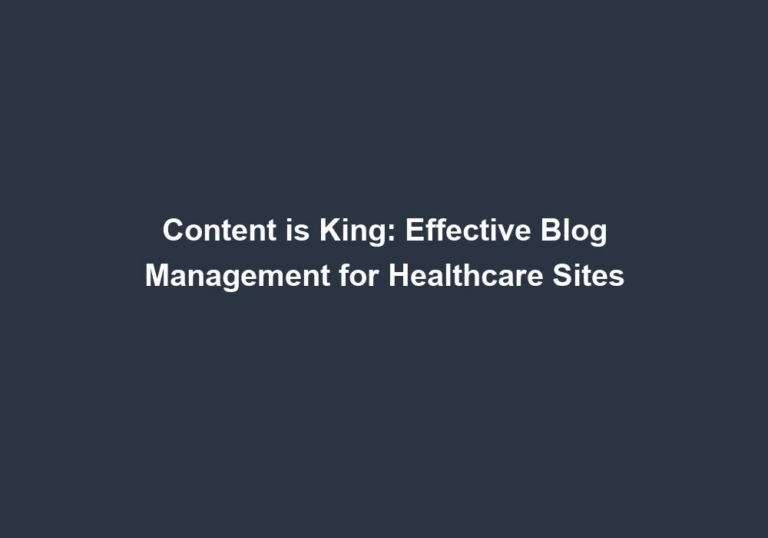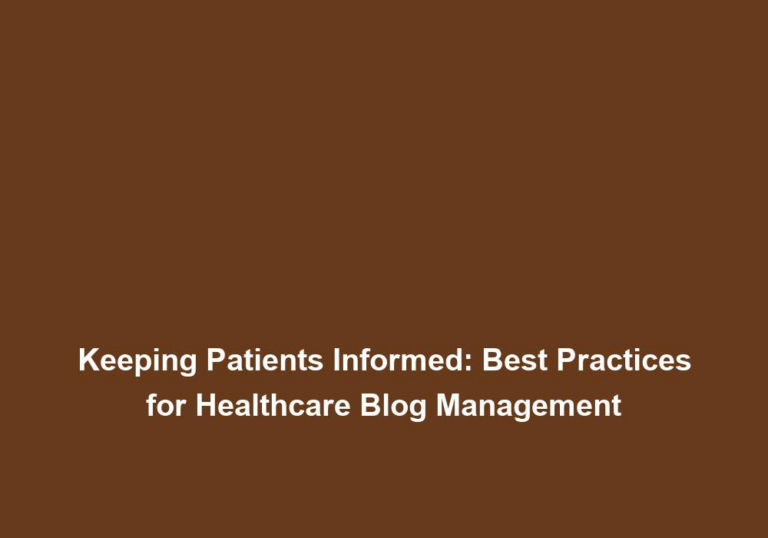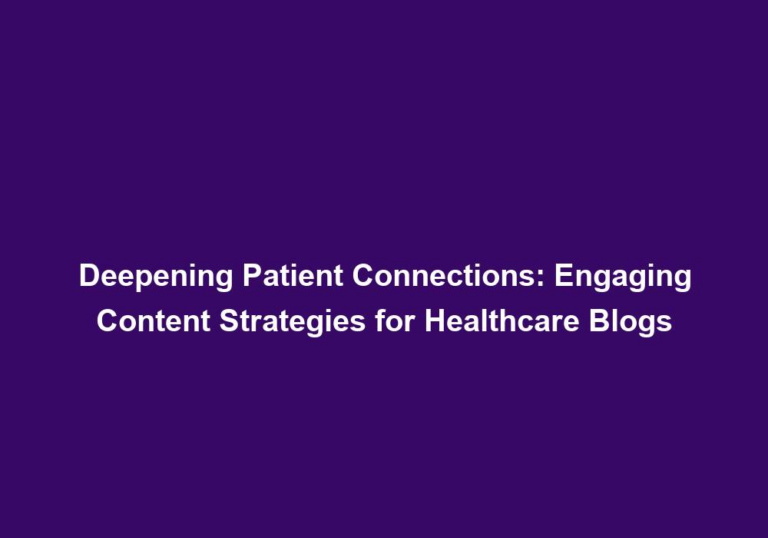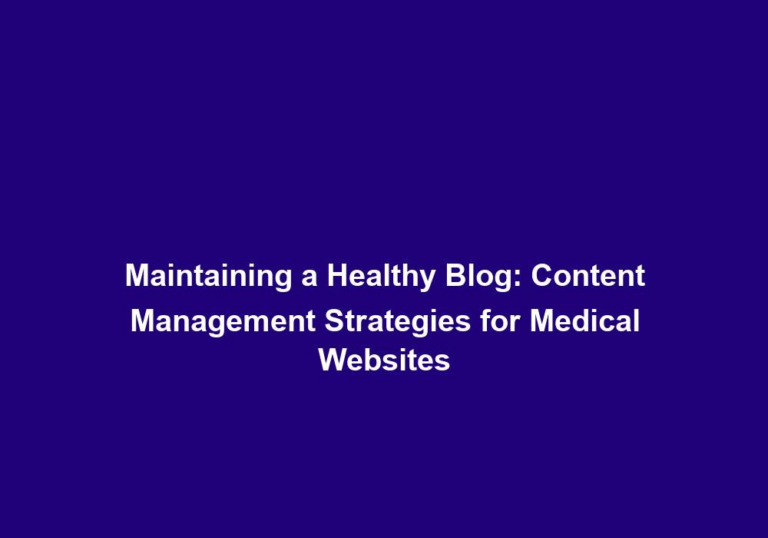The Heart of Patient Care: Engaging and Informative Blog Content Strategies
In the rapidly evolving healthcare industry, patient care and communication play a pivotal role in establishing a strong connection between healthcare providers and their patients. One of the most effective ways to engage and inform patients is through well-crafted blog content. This article explores strategies for creating engaging and informative blog content that can enhance the patient experience and foster a deeper understanding of healthcare topics.
Why Blog Content Matters in Patient Care
Blogs have become an integral part of healthcare organizations’ online presence, serving as a valuable platform to educate and engage patients. By providing relevant and up-to-date information, healthcare providers can establish themselves as credible sources of knowledge, build trust with patients, and improve overall patient care. Here are some key reasons why blog content matters in patient care:
- Education and Empowerment: Blog content allows healthcare providers to educate patients about various health conditions, treatment options, preventive measures, and lifestyle choices. When patients are well-informed, they can actively participate in their own care and make informed decisions.
- By providing detailed information about health conditions, patients can gain a better understanding of their own health and treatment options.
- Blog content can also empower patients to take proactive measures to prevent certain health conditions and adopt healthy lifestyle choices.
- Building Trust and Credibility: Regularly publishing informative and accurate blog content helps healthcare providers establish trust and credibility among patients. By sharing expertise and insights, providers can position themselves as reliable sources, creating a sense of confidence and loyalty among patients.
- Well-crafted blog content showcases the expertise of healthcare providers, demonstrating their knowledge and authority in the field.
- By consistently providing accurate and reliable information, healthcare providers can build trust with patients, who will then feel more confident in their care.
- Addressing Patients’ Concerns: Blog content provides a platform for addressing common concerns, dispelling myths, and clarifying misconceptions. By proactively addressing patient questions and concerns, healthcare providers can alleviate anxiety, reduce uncertainties, and foster a positive patient experience.
- Blog content can address frequently asked questions, providing patients with clear and accurate information to address their concerns.
- By debunking myths and clarifying misconceptions, healthcare providers can help patients make informed decisions about their health.
- Enhancing Patient Engagement: Engaging blog content encourages patients to actively participate in their care journey. By writing about patient success stories, innovative treatment approaches, and community initiatives, healthcare providers can inspire patients to take an active role in their own well-being.
- Sharing patient success stories can motivate and inspire other patients, giving them hope and encouragement throughout their own healthcare journey.
- By highlighting innovative treatment approaches and community initiatives, healthcare providers can promote a sense of collaboration and involvement among patients.
- Improving SEO and Online Visibility: Well-optimized blog content can significantly improve a healthcare organization’s online visibility. By incorporating relevant keywords, meta tags, and high-quality content, healthcare providers can enhance their search engine rankings, attracting more patients to their website.
- Conducting thorough keyword research and strategically incorporating relevant keywords throughout blog content can help healthcare providers rank higher in search engine results.
- Optimizing meta tags and utilizing high-quality content can further improve search engine visibility and attract more organic traffic to the website.
Strategies for Creating Engaging and Informative Blog Content
Now that we understand the importance of blog content in patient care, let’s explore some effective strategies for creating engaging and informative blog posts. By following these strategies, healthcare providers can maximize the impact of their blog content and foster meaningful patient engagement.
1. Understand Your Audience
To create compelling blog content, it is crucial to understand your target audience. Conduct thorough research to identify the demographics, interests, and information needs of your patients. By tailoring your content to their specific preferences, you can effectively capture their attention and provide valuable insights.
- Analyze patient demographics, such as age, gender, and location, to understand their unique needs and preferences.
- Consider conducting surveys or interviews to gather direct feedback from patients regarding the type of content they find most helpful and engaging.
- Use analytics tools to track user behavior on your website, such as page views and time spent on each article, to gain insights into which topics resonate most with your audience.
2. Choose Relevant Topics
Selecting relevant topics is key to engaging your audience. Consider the common health concerns, frequently asked questions, and emerging trends in your field. By addressing these topics, you can provide helpful information that resonates with your patients and demonstrates your expertise in the area.
- Stay up-to-date with the latest advancements and trends in healthcare to identify relevant topics that are of interest to your patients.
- Monitor social media platforms and online forums to identify common questions and concerns among your target audience.
- Utilize keyword research tools to identify popular search terms related to your healthcare specialty, ensuring that your blog content aligns with patients’ information needs.
3. Craft Engaging Headlines
Captivating headlines are vital for attracting readers to your blog posts. Use concise, attention-grabbing headlines that clearly convey the article’s main subject and pique readers’ curiosity. Additionally, incorporating relevant keywords in your headlines can improve your blog’s visibility in search engine results.
- Use action words and power words to create impactful headlines that grab readers’ attention.
- Clearly communicate the main focus or benefit of the article in the headline to entice readers to click and read further.
- Incorporate relevant keywords naturally in the headlines to improve search engine optimization and attract organic traffic.
4. Use Storytelling Techniques
Storytelling is a powerful tool for engaging readers and conveying complex healthcare information in an accessible manner. Incorporate patient success stories, real-life examples, or personal experiences to make your blog content relatable and emotionally impactful.
- Share inspiring stories of patients who have overcome health challenges, highlighting their journey and the impact of proper care.
- Use real-life examples to illustrate complex medical concepts, making them easier for patients to understand and relate to their own situations.
- Personalize the content by sharing experiences and perspectives from healthcare providers or staff, fostering a sense of connection and trust with readers.
5. Optimize for Search Engines
To ensure maximum visibility, optimize your blog content for search engines. Conduct keyword research to identify relevant terms and incorporate them naturally throughout your blog posts. Additionally, utilize meta tags, headings, and alt-text for images to improve search engine rankings and accessibility.
- Research and incorporate relevant keywords throughout the blog content to improve its visibility in search engine results.
- Utilize meta tags, including meta descriptions, to provide concise summaries of your blog posts, increasing the chances of attracting clicks from search engine users.
- Use heading tags (H1, H2, H3, etc.) to structure your content and make it easier for search engines to understand the hierarchy and relevance of the information.
- Add alt-text to images to ensure that visually impaired individuals and search engines can understand the content of the images.
6. Incorporate Visuals and Multimedia
Visual elements such as images, infographics, and videos can significantly enhance the appeal and readability of your blog content. Visuals not only break up the text but also help convey complex information more effectively. Ensure that your visuals are relevant, high-quality, and accessible to all readers.
- Use high-resolution images that are related to the topic to enhance the visual appeal of your blog posts.
- Create infographics or charts to present data or statistics in a visually engaging and easy-to-understand format.
- Embed videos or audio clips to provide additional context or demonstrate medical procedures, making the content more interactive and informative.
7. Encourage Interaction and Feedback
Encourage readers to engage with your blog content by enabling comments and social media sharing. Responding to comments and addressing feedback demonstrates your commitment to patient care and fosters a sense of community among your readers.
- Enable comments on your blog posts to encourage readers to share their thoughts, ask questions, or provide feedback.
- Respond promptly and thoughtfully to comments, showing your dedication to addressing readers’ concerns and fostering a supportive community.
- Encourage social media sharing by adding social sharing buttons to your blog posts, making it easy for readers to share valuable content with their networks.
8. Collaborate with Experts
Consider collaborating with healthcare professionals and subject matter experts to provide comprehensive and authoritative blog content. Guest posts or expert interviews can add further credibility to your content, attract a wider audience, and foster valuable partnerships within the industry.
- Reach out to other healthcare professionals or experts in your field to contribute guest posts or provide insights on specific topics.
- Conduct interviews with experts to gather their perspectives and share their valuable knowledge with your readers.
- Collaborating with experts not only enhances the credibility of your blog content but also helps you tap into their existing audience, expanding your reach.
9. Promote Across Multiple Channels
To reach a wider audience, promote your blog content across various channels. Share your articles on social media platforms, email newsletters, and other relevant online communities. This multi-channel approach ensures that your content reaches patients wherever they are, increasing its impact and visibility.
- Share links to your blog posts on social media platforms such as Facebook, Twitter, LinkedIn, and Instagram, utilizing relevant hashtags and engaging captions.
- Include snippets or teasers of your blog content in your email newsletters to entice subscribers to click through and read the full articles.
- Participate in online communities, forums, or groups related to your healthcare specialty, sharing valuable insights from your blog content and establishing yourself as a trusted authority.
By implementing these strategies, healthcare providers can create engaging, informative, and patient-centric blog content that serves as a valuable resource for patients seeking reliable healthcare information. By fostering a culture of continuous learning and patient empowerment, healthcare organizations can strengthen their patient relationships and provide exceptional care.


